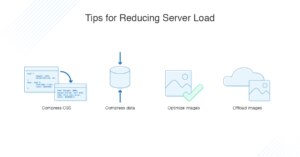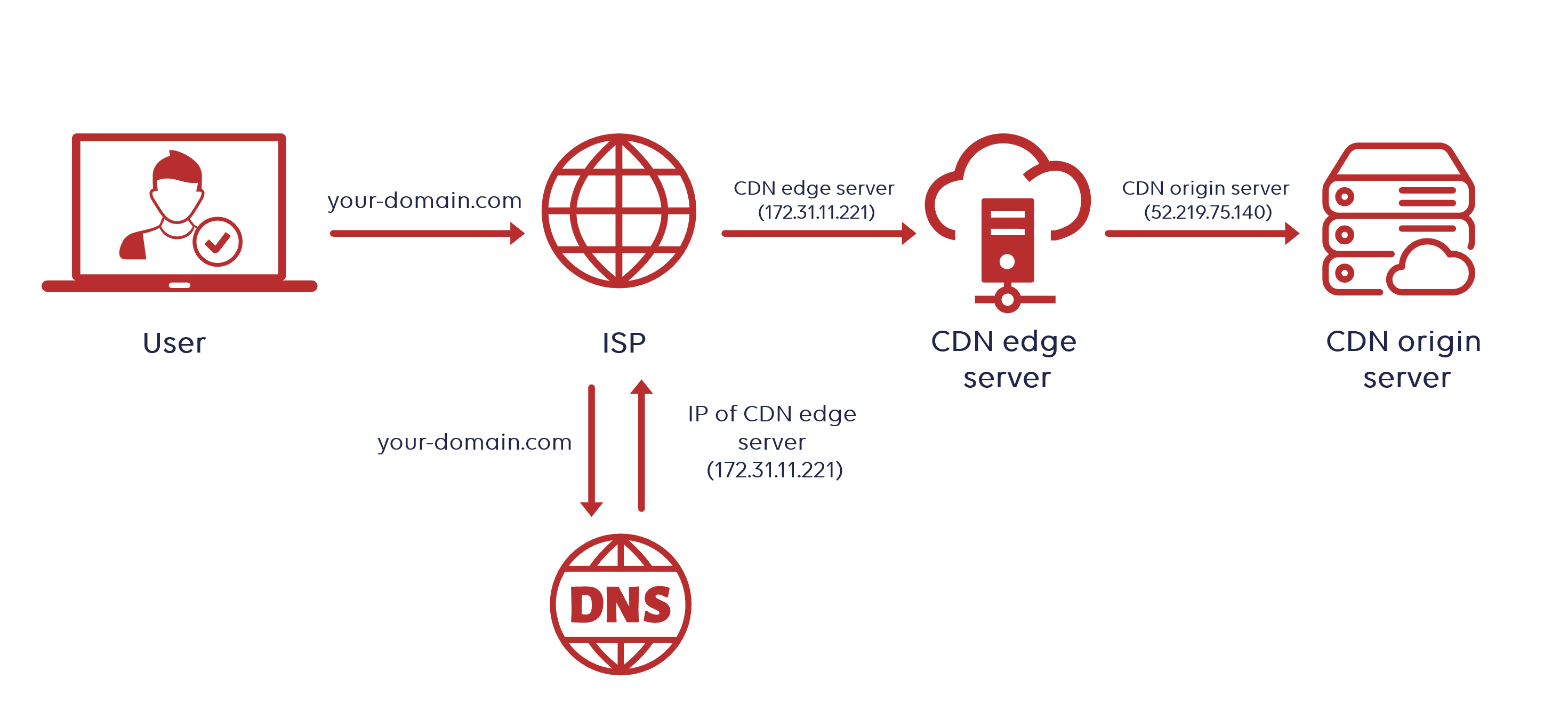Content Delivery Networks (CDNs)

CDNs are networks of distributed servers that deliver content to users from geographically dispersed locations. By caching and serving content closer to users, CDNs reduce the load on origin servers and improve performance for end-users.

Benefits:

- Reduces server load by distributing content across multiple servers.
- Improves page load times and reduces latency for users.
- Decreases bandwidth costs by serving content from locations closer to users.
How CDNs Work:
- User requests content from origin server.
- CDN serves the content from a nearby server, if cached.
- If not cached, CDN retrieves the content from the origin server and caches it for future requests.
Edge Caching
Edge caching involves storing content at the edge of the network, closer to users. By caching content on servers located in regional data centers, CDNs can reduce the distance data needs to travel, further improving performance and reducing server load.
Benefits:
- Even lower latency and faster page load times.
- Reduced strain on infrastructure during peak usage periods.
- Improved user experience and satisfaction.
Optimized Traffic Routing
CDNs use advanced traffic management algorithms to route user requests to the optimal server based on factors such as location, network conditions, and server load. This ensures that content is delivered from the fastest and most efficient route possible.
Benefits:
- Improved performance and reliability.
- Reduced server congestion and load balancing.
- Optimization of network resources.
Additional Benefits of CDNs:
- Cost savings: CDNs can reduce bandwidth costs and server maintenance expenses.
- Security: CDNs can provide DDoS protection and other security measures.
- Scalability: CDNs allow for easy scaling of content delivery to meet increasing demand.
- Analytics: CDNs provide valuable insights into user behavior and website performance.
By implementing a CDN, organizations can significantly reduce server load and costs while improving the overall performance and user experience of their websites and applications.# How Cdns Help In Reducing Server Load And Costs
Executive Summary
Content delivery networks (CDNs) play a crucial role in optimizing website performance, reducing server load, and minimizing infrastructure costs. By strategically distributing content across a globally dispersed network of servers, CDNs enable faster delivery of web content to end-users, reducing the strain on origin servers and improving overall user experience. This article delves into the key benefits of CDNs in reducing server load and costs, exploring its various aspects and providing insights into its implementation and optimization strategies.
Introduction
In today’s digital landscape, website speed and performance are paramount for user satisfaction and business growth. With the increasing volume of web content and the growing expectations of online users, traditional web hosting solutions often struggle to handle the surge in traffic and deliver content efficiently. Content delivery networks (CDNs) have emerged as a powerful solution to these challenges, offering a cost-effective and scalable way to reduce server load and optimize website performance.
FAQs
Q1. What is a CDN, and how does it work?
A1. A CDN is a distributed network of servers that store and deliver web content to users based on their geographic location. When a user requests a file from a website using a CDN, the request is routed to the nearest CDN server, which then delivers the file directly to the user. This reduces the distance and latency involved in accessing the content, resulting in faster load times and improved user experience.
Q2. How do CDNs help in reducing server load?
A2. By caching static content, such as images, videos, and CSS files, on their servers, CDNs significantly reduce the load on origin servers. Instead of retrieving the content directly from the origin server every time a user requests it, CDNs can serve the content from their local servers, which are geographically closer to the users, thereby reducing the response times and freeing up the origin server to handle more critical tasks.
Q3. Do CDNs come with any costs?
A3. While CDNs offer significant benefits, they typically come with subscription fees or pay-as-you-go pricing models. However, the cost savings achieved through reduced server load, improved performance, and increased user engagement often outweigh the expenses associated with CDN services. Businesses should carefully evaluate their needs and usage patterns to determine the optimal CDN solution that aligns with their budget and requirements.
Subtopics
1. Content Caching
- Reduces server load: By caching static content on their geographically distributed servers, CDNs reduce the load on origin servers, as users can access cached content from the nearest CDN server instead of directly from the origin server.
- Improves website performance: Caching content on CDN servers reduces latency and improves website load times, as users can access content from servers that are physically closer to them.
- Supports high traffic spikes: CDNs can handle high traffic volumes by distributing content across multiple servers, preventing the origin server from becoming overloaded and ensuring uninterrupted access to the website.
- Minimizes bandwidth consumption: By serving content from servers located near users, CDNs reduce the distance data needs to travel, minimizing bandwidth consumption and reducing costs associated with data transfer.
- Enhances SEO: Faster loading websites rank higher in search engine results pages (SERPs), as Google and other search engines prioritize user experience, including website speed, in their ranking algorithms.
2. Load Balancing
- Distributes traffic evenly: CDNs use load balancing techniques to distribute traffic across multiple servers, preventing any single server from becoming overloaded.
- Improves website availability: By balancing the load, CDNs ensure that users can access the website even during peak traffic times, increasing the website’s overall availability and reliability.
- Enhances scalability: CDNs allow businesses to scale their website infrastructure effortlessly by adding or removing servers as needed to handle changes in traffic volume.
- Reduces latency: By distributing content across multiple servers, CDNs reduce the latency between the user and the content, resulting in faster loading times and improved website performance.
- Improves user experience: Load balancing ensures that users experience consistent and reliable performance, regardless of their location or the traffic load on the website.
3. Geolocation and Edge Computing
- Localizes content delivery: CDNs use geolocation to identify users’ locations and deliver content from the nearest server, reducing latency and improving content accessibility.
- Reduces bandwidth costs: By delivering content from servers located near users, CDNs minimize the distance data needs to travel, reducing bandwidth consumption and associated costs.
- Supports local languages and content: CDNs can store and deliver content in multiple languages and formats, ensuring that users can access localized and relevant content regardless of their location.
- Enhances user engagement: Localized content and faster delivery times improve user engagement, increasing the likelihood of conversions and repeat visits to the website.
- Strengthens compliance with data regulations: CDNs can help businesses comply with data regulations, such as GDPR, by storing and processing data in specific geographic regions.
4. Security and DDoS Protection
- Defends against DDoS attacks: CDNs provide DDoS (Distributed Denial of Service) protection by filtering out malicious traffic and distributing legitimate traffic across multiple servers, making it difficult for attackers to overwhelm the origin server.
- Improves website security: CDNs can implement various security measures, such as SSL encryption, web application firewalls (WAFs), and malware scanning, to protect websites from cyber threats and data breaches.
- Enhances data protection: CDNs can help businesses meet data protection and privacy regulations by encrypting data in transit and at rest, ensuring the confidentiality and integrity of sensitive information.
- Provides access control: CDNs allow businesses to restrict access to certain content based on geographic location, IP address, or other criteria, enhancing website security and protecting sensitive information.
- Monitors website traffic: CDNs provide real-time monitoring and analytics of website traffic, allowing businesses to identify potential security threats and performance issues proactively.
5. Cost Optimization
- Reduces bandwidth costs: By caching content on CDN servers and delivering it from the nearest location, CDNs reduce the distance data needs to travel, minimizing bandwidth consumption and associated costs.
- Improves server efficiency: By reducing the load on origin servers, CDNs allow businesses to downsize or eliminate unnecessary servers, resulting in cost savings on hardware and maintenance.
- Scales on demand: CDNs offer flexible pricing models that allow businesses to pay only for the resources they use, eliminating the need for upfront investments in infrastructure.
- Supports hybrid cloud solutions: CDNs can integrate with hybrid cloud environments, allowing businesses to leverage the cost-effectiveness of public cloud while maintaining control over sensitive data on private clouds.
- Increases revenue potential: By improving website performance and user experience, CDNs can indirectly increase revenue by enhancing conversion rates, reducing bounce rates, and improving customer satisfaction.
Conclusion
Content delivery networks (CDNs) play a transformative role in reducing server load and optimizing website performance. By caching content, balancing load, leveraging geolocation, enhancing security, and offering cost optimization, CDNs empower businesses to deliver a seamless and engaging user experience while minimizing infrastructure costs. Implementing a CDN as part of a comprehensive website strategy can lead to significant improvements in website speed, reliability, and security, ultimately driving business growth and customer satisfaction.
Keyword Tags
- Content Delivery Network (CDN)
- Server Load Reduction
- Website Performance Optimization
- Cloud Computing
- Data Center Optimization
